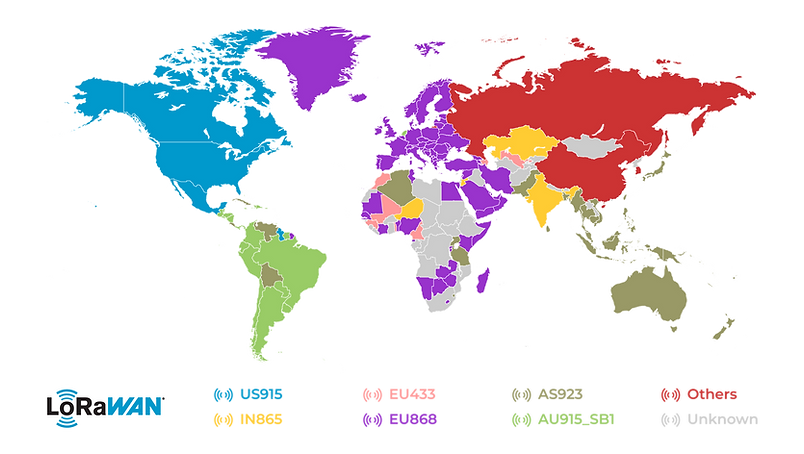Daviteq Technologies
LORAWAN®
LoRaWAN® (Long Range Wide Area Network) is a low-power, wide-area networking protocol for wireless, battery-powered IoT devices. It allows sensors to communicate with gateways over long distances while consuming very little energy.
This makes LoRaWAN ideal for applications in remote or hard-to-access areas where devices need to operate for years without frequent battery replacement.
How Does LoRaWAN® Work?
LoRaWAN® operates in unlicensed radio frequency bands such as 868 MHz in Europe or 915 MHz in the US. It uses a star-of-stars architecture, where end devices (sensors) send data to gateways. The gateways then forward this data to a central network server via standard IP connections.
The network server processes and routes the information to applications or databases, enabling secure and efficient IoT communication. Thanks to this structure, thousands of devices can connect to a single gateway, making LoRaWAN highly scalable and cost-effective for large deployments.

LoRaWAN uses a star-of-stars network topology to connect low-power IoT devices over long distances. Here’s a simplified breakdown of how it works:
1. End Devices (Sensors & Nodes)
IoT sensors such as temperature, soil moisture, or smart meters send small data packets using LoRa modulation. Example: a soil sensor sends moisture data every 15 minutes.
Example: A soil sensor sends data every 15 minutes about moisture levels.
2. Gateways
Act like base stations. They receive LoRa signals and forward them as IP packets (via Wi-Fi, Ethernet, or LTE) to the network server.
3. Network Server
The brain of the system. It manages device connections, removes duplicate packets, applies security (decryption, authentication), and routes data to the application server.
4. Application Server
This is where data becomes useful. The application server visualises, analyses, or triggers actions based on the incoming data — like adjusting irrigation, sending alerts, or logging sensor history.

LoRaWAN® Key Features
Long range coverage
Up to 15–20 km in rural areas, 2–5 km in urban areas
Ultra-low power consumption
Devices can operate for 5–10 years on a single battery
Flexible deployment
Can use public networks or deploy private networks
Low operating cost
No high monthly mobile data fees, reducing total cost of ownership
Supports a large number of devices
Thousands of nodes can connect to a single gateway
Low bandwidth
Data rates from only 0.3 kbps to 50 kbps, not suitable for large data volumes
High latency
Not suitable for applications requiring real-time response
Not suitable for high-speed mobility
Optimized for stationary or slow-moving devices

LoRaWAN® Applications
LoRaWAN technology enables a wide range of IoT applications.
At Daviteq, our wireless sensors and solutions are applied across key sectors
Smart
Factory

Enabling seamless machine-to-machine communication, LoRaWAN empowers factories with in-time monitoring, predictive maintenance, and optimized operations - reducing downtime and boosting productivity.

From soil moisture, pH, ambient light, and temperature sensors to livestock tracking, LoRaWAN provides in-time insights that help farmers increase yields, save resources, and practice sustainable farming.
Smart
City

LoRaWAN transforms urban life with connected streetlights, smart waste bins, and air quality monitors - making cities cleaner, safer, and more efficient for residents.
LoRaWAN® & Other Connectivities
Title |
|---|
Coverage Range |
Data Rate |
Power Consumption |
Device/ Service Cost |
Required Infrastructure |
Typical Applications |
LoRaWAN | Sigfox | Sub-1GHz | NB-IoT |
|---|---|---|---|
2–15 km (urban), 15–40 km (rural) | 3–10 km (urban), 30–50 km (rural) | 1–10 km | 1–10 km (excellent indoor penetration) |
0.3–50 kbps | 100 bps uplink, 600 bps downlink | Several kbps to hundreds of kbps | 26–250 kbps |
Very low | Very low | Very low | Low to medium |
Low | Low (subscription-based) | Low | Medium (IoT SIM) |
Private gateways or public LoRaWAN network | Sigfox network | Self-deployed network | NB-IoT mobile network |
Smart factory, smart agriculture, smart cities, smart building, logistics tracking | Low-cost asset tracking, utility meters, simple low-cost sensors, simple alarm & monitoring systems | Warehouse monitoring, environment monitoring, industrial monitoring and control | Smart meters, environmental monitoring, smart parking, healthcare devices, logistics tracking |
Daviteq LoRaWAN Sensors & Actuators
Daviteq provides a wide range of LoRaWAN-based sensors and actuators built for industrial-grade performance, ultra-low power operation, and long service life.
-
LoRaWAN specification V1.0.3 – fully compliant with global standards.
-
Class A for sensors & Class C for actuators – optimized for different IoT use cases.
-
High-efficiency antenna (standard, with optional external antenna).
-
10-year lifetime battery (2 × AA 1.5V Alkaline/Lithium) – optional solar energy harvesting.
-
IP67/68 protection – suitable for harsh indoor and outdoor environments.
-
CE / FCC certification available on request.
-
Wide sensor portfolio – temperature, humidity, pressure, level, vibration, CO₂, NH₃, Cl₂, H₂S, and more.
Daviteq’s LoRaWAN sensors deliver long-lasting, reliable IoT connectivity for smart factory, smart agriculture, and smart city applications.
 |  |  |
|---|
LoRaWAN® Sensors
 |
|---|
 |
 |
LoRaWAN® Actuators
 |
|---|
 |
LoRaWAN® Gateways
Resources
Frequently Asked Questions
Find quick answers to common questions about wireless connectivity, compatibility, and how to choose the right technology for your IoT deployment.
Is LoRaWAN better than WiFi?
LoRaWAN is not a replacement for WiFi but a complementary technology. While WiFi provides high data rates over short distances, LoRaWAN focuses on long-range, low-power communication for IoT devices. This makes LoRaWAN better suited for battery-powered sensors that need to send small amounts of data over several kilometers.
Can LoRa work without internet?
Yes. LoRa communication between end devices and gateways does not require the internet. A LoRaWAN gateway can forward data to a local server over Ethernet, WiFi, or cellular networks. However, if you want to access sensor data remotely (e.g., through cloud dashboards), an internet connection is needed at the gateway or server level.
Can LoRaWAN go through walls?
Yes, LoRaWAN signals can penetrate walls and other obstacles better than WiFi or Bluetooth, thanks to sub-GHz frequency bands. However, the range depends on building materials and environment: concrete and metal reduce penetration more than wood or glass. In urban areas, LoRaWAN typically covers 2–5 km even with obstructions.
Is LoRaWAN obsolete?
No. LoRaWAN is an active global IoT standard maintained by the LoRa Alliance and adopted by thousands of companies worldwide. It continues to grow in smart agriculture, smart cities, and industrial IoT, with strong ecosystem support and regular updates to specifications.
Got more questions?





